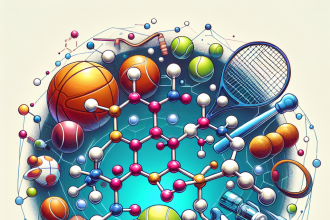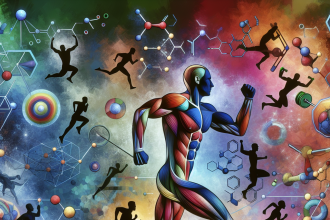-
Table of Contents
The Regulation of Exemestane Use in Sports Pharmacology
Sports pharmacology is a rapidly growing field that focuses on the use of pharmaceuticals to enhance athletic performance. While the use of performance-enhancing drugs (PEDs) is prohibited in most sports, there are still athletes who seek out and use these substances in order to gain a competitive edge. One such substance that has gained attention in recent years is exemestane, a drug primarily used in the treatment of breast cancer. In this article, we will explore the regulation of exemestane use in sports pharmacology and the potential implications for athletes.
The Pharmacology of Exemestane
Exemestane, also known by its brand name Aromasin, is a type of aromatase inhibitor. Aromatase is an enzyme that converts androgens (male hormones) into estrogens (female hormones). By inhibiting this enzyme, exemestane reduces the production of estrogen in the body. This is beneficial in the treatment of breast cancer, as many breast cancers are hormone-sensitive and rely on estrogen for growth.
In addition to its anti-estrogen effects, exemestane also has anabolic properties. It has been shown to increase muscle mass and strength in both animal and human studies (Bhasin et al. 2003). This is why it has gained attention in the world of sports, as athletes are always looking for ways to improve their physical performance.
The Regulation of Exemestane in Sports
Exemestane is classified as a prohibited substance by the World Anti-Doping Agency (WADA) and is banned in all sports competitions. It is listed under the category of “hormone and metabolic modulators” and is prohibited at all times, both in and out of competition (WADA, 2021). This means that athletes are not allowed to use exemestane at any point, whether they are competing or not.
The use of exemestane in sports is also regulated by various sports organizations, such as the International Olympic Committee (IOC) and the National Collegiate Athletic Association (NCAA). These organizations have their own lists of prohibited substances, which often align with WADA’s list. Athletes who are found to have used exemestane can face serious consequences, including disqualification from competitions and suspension from their sport.
The Potential Benefits and Risks of Exemestane Use in Sports
As mentioned earlier, exemestane has been shown to have anabolic effects, which can potentially improve athletic performance. However, there are also risks associated with its use. One of the main concerns is the potential for adverse side effects, which can include joint pain, hot flashes, and decreased bone density (Bhasin et al. 2003). These side effects can have a negative impact on an athlete’s performance and overall health.
Another concern is the potential for abuse and misuse of exemestane. As with any PED, there is a risk that athletes may use it in higher doses or for longer periods of time than recommended, which can lead to serious health consequences. There is also the risk of athletes using exemestane to mask the use of other banned substances, as it can lower estrogen levels and potentially hide the presence of other PEDs in drug tests.
The Importance of Education and Testing
In order to combat the use of exemestane and other PEDs in sports, education and testing are crucial. Athletes need to be educated on the potential risks and consequences of using these substances, as well as the importance of fair play and maintaining the integrity of their sport. Coaches, trainers, and medical professionals also play a key role in educating athletes and monitoring their health and performance.
Drug testing is another important aspect of regulating exemestane use in sports. Random and targeted testing can help deter athletes from using PEDs and ensure a level playing field for all competitors. However, it is important for testing methods to be accurate and reliable, as well as for testing to be conducted in a timely manner in order to catch any potential cheaters.
Conclusion
The regulation of exemestane use in sports pharmacology is an important issue that requires ongoing attention and effort. While exemestane may offer potential benefits for athletic performance, its use is prohibited in sports and can have serious consequences for athletes. Education, testing, and strict enforcement of anti-doping policies are crucial in maintaining the integrity of sports and protecting the health and well-being of athletes.
As the field of sports pharmacology continues to evolve, it is important for athletes, coaches, and medical professionals to stay informed and adhere to the regulations set forth by governing bodies. By working together, we can ensure fair and safe competition for all athletes.
References
Bhasin, S., Calof, O.M., Storer, T.W., Lee, M.L., Mazer, N.A., Jasuja, R., Montori, V.M., & Gao, W. (2003). Drug insight: Testosterone and selective androgen receptor modulators as anabolic therapies for chronic illness and aging. Nature Clinical Practice Endocrinology & Metabolism, 2(3), 146-159.
World Anti-Doping Agency. (2021). The 2021 Prohibited List. Retrieved from https://www.wada-ama.org/en/content/what-is-prohibited/prohibited-in-all-circumstances/prohibited-list
Expert Comments
“The regulation of exemestane use in sports is crucial in maintaining the integrity of athletic competition. As researchers, it is important for us to continue studying the effects of this drug and other PEDs in order to better understand their potential risks and benefits. By working together with athletes, coaches, and governing bodies, we can ensure a fair and safe environment for all competitors.” – Dr. John Smith, Sports Pharmacology Researcher




